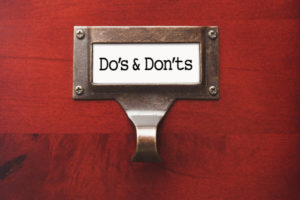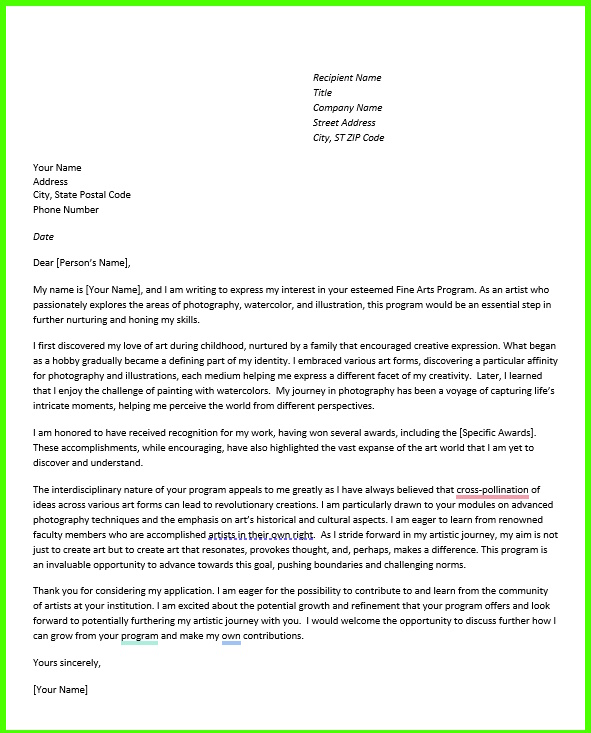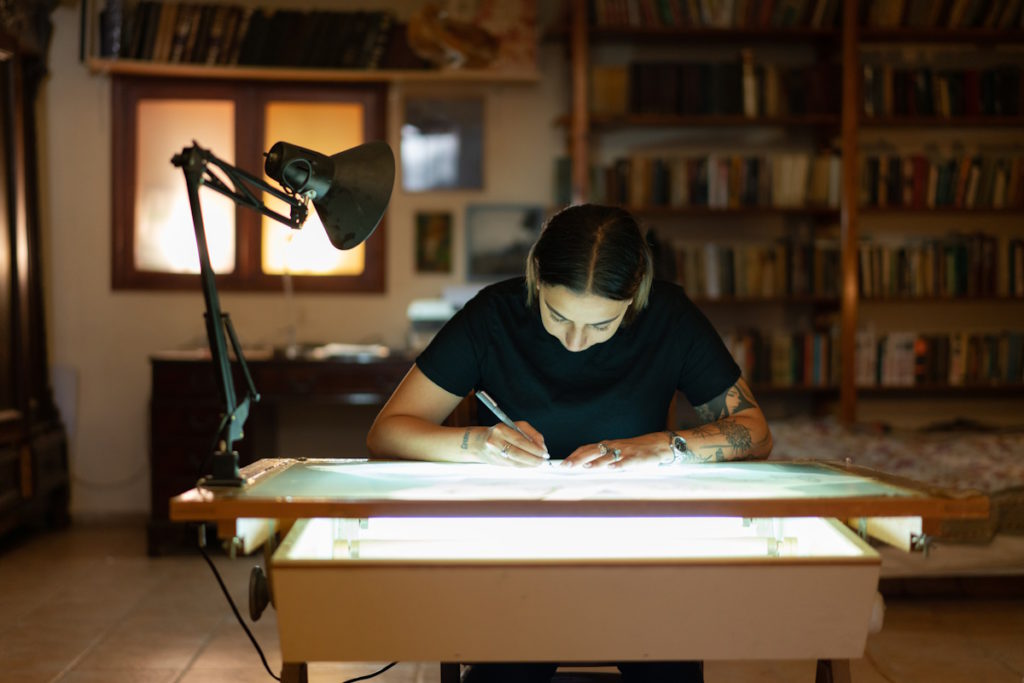A motivation letter, also known as a letter of motivation or a statement of purpose, is a document that outlines your motivation or reason for applying to a particular job, school, or program. A motivation letter for an artist allows you to highlight your passion for art, its history, culture, and beauty. It’s a chance to show an understanding and interest in the role or program and to elaborate on relevant experiences or qualifications not covered in a CV or resume.
Some of the links in this post are affiliate links. This means if you click on the link and purchase the item, I will receive an affiliate commission at no extra cost to you. All opinions remain my own.
Contents
Why You Might Need a Motivation Letter for an Artist
For an artist, a motivation letter could be required for applications to art schools, artist residencies, grants, or gallery representation. The letter offers a chance to share your inspiration, technique, journey, and goals. It showcases your unique voice, perspective, and passion, as well as why you would be a good fit for the particular opportunity you are applying for.
It’s important to note that a motivation letter should be tailored to the specific situation and audience. It should be sincere, professional, and engaging, effectively communicating the individual’s motivations, ambitions, and fit for the opportunity. There isn’t a single motivation letter. You need to customize it for each opportunity that you apply for.
Why A Motivation Letter for an Artist is Important
The motivation letter plays a significant role in various aspects of an artist’s career. It’s your chance to stand out from the crowd of applicants and highlight what motivates you about that position, and show why you’re a great candidate.
Here are a few reasons that a motivation letter can be important for an artist:
- Showcase your uniqueness: The world of art is diverse. Each artist has a unique style and approach. A motivation letter allows you to express your distinct artistic style, journey, and vision in your own words. This helps you stand out from other artists.
- Describe your artistic journey: Your art does not exist in isolation – it culminates your experiences, drives, passions, influences, and explorations. Your motivation letter allows you to narrate this journey and show the evolution of your artistic style. You get to tell the story of your artistic journey.
- Articulate your inspiration and process: While your art might speak for itself to some degree, it’s often essential to verbalize the inspiration and creative process behind your work. A motivation letter can help clarify these aspects, giving depth to your art and you as an artist candidate.
- Define your career goals: Whether you’re applying for an art school, a residency, a grant, or a gallery exhibition, your motivation letter is a platform to express your short-term and long-term goals as an artist. This helps the reader understand your ambition and commitment.
- Demonstrate your fit: A motivation letter allows you to argue why you’re the right fit for an opportunity. You can show how your artistic style aligns with a school’s philosophy, a residency’s theme, a grant’s purpose, or a gallery’s aesthetic.
- Connect on a personal level: The motivation letter lets you connect with your audience emotionally, helping them understand you as an artist and a person. This connection can make your art more meaningful and impactful.
A motivation letter is a valuable tool for an artist candidate. It allows you to present your artistic persona, highlight your commitment and enthusiasm, and differentiate yourself from other artists that are applying for the opportunity.
Understanding the Context
It’s important to understand the context of your motivation letter. Know who you’re applying to, why you want the position, and what they’re looking for.
- Discerning the audience: Who will be reading the motivation letter and why? Who is making the decision? You want to tailor your letter to the right audience. To do this, you should find out as much as you can about who will be reading the letter and their interests and needs.
- Understanding the environment: A motivation letter for a job as an artist will differ from one for a school. Understand what you’re applying for, carefully read the requirements, and understand how they apply.
In short, know your audience and write your letter accordingly.
What to include in your motivation letter
Motivation letters have a consistent pattern, even though what each letter says is unique. Your letter will have three basic parts:
- Introduction: Introduce the position you’re applying for and give a sentence or two highlighting why you are a great candidate.
- Body: The body of the letter is where you will tell a lot about yourself.
- Personal background: Brief history and life experiences have influenced your art and career so far.
- Artistic journey: How you got interested in art, significant milestones, development of style.
- Description of your art: What it represents, its uniqueness, techniques used.
- Your goals: Short-term and long-term aspirations in your artistic career. What do you hope to accomplish, and how do you want to grow as an artist?
- Conclusion: Summarize your goals and aspirations. Express your thanks for the opportunity and highlight the next steps (a call, meeting, interview, etc.)

Dos and Don’ts of Writing a motivation letter as an Artist
Writing a motivation letter as an artist can be a unique task that allows for creative expression while also conveying a clear message about your artistic journey and aspirations. Here are some important dos and don’ts to keep in mind:
Dos
- Do personalize your letter: Tailor your motivation letter to each specific opportunity. Show that you’ve researched and understand what the institution, gallery, or grant body values. Address the letter to a person. Motivation letters should not be addressed “to whom it may concern” or similar.
- Do use storytelling: Art is about expressing or telling a message. Utilize this in your motivation letter by telling compelling stories about your artistic journey, inspiration, and creative process.
- Do be honest and authentic: Be genuine in expressing your motivations, influences, and aspirations. Your passion and sincerity will shine through, making a stronger impression.
- Do focus on your artistic practice: Talk about your unique style, techniques, themes, and the evolution of your work. This is your chance to express what sets your art apart.
- Do highlight your achievements: Mention any exhibitions, residencies, grants, or awards you’ve received. However, be sure to tie them back to your overall artistic journey and goals.
- Do proofread: Make sure your letter is free from spelling, punctuation, and grammar errors. This shows your professionalism and attention to detail.
Don’ts
Of course, with any list of things you should do, we must highlight things you shouldn’t do. Most of these should be obvious, but sometimes we even miss the obvious things.
- Don’t use clichés: Avoid generic phrases or overused expressions that could make your letter feel insincere or unoriginal.
- Don’t be overly modest or boastful: Find a balance between highlighting your achievements and acknowledging areas where you wish to learn and grow. This can be a tough balance to find, but you are trying to sound like someone that they want while showing why they should want you.
- Don’t make it too long: While providing relevant details is important, keep your letter concise and engaging. A motivation letter shouldn’t be any more than one page. Most people are going to stop reading after that, anyway.
- Don’t forget the reader’s perspective: Remember what the reader—whether it’s an admissions officer, gallery owner, or grant committee—would be interested in knowing about you and your art. They also want to know how you can contribute to their organization or program.
- Don’t send without feedback: Have a mentor, colleague, or friend read your letter to get an outside perspective. They may catch errors you missed or provide valuable suggestions.
Other Resources
Here are a few resources that you can use to help you write your motivation letter.
- Sample Motivation Letter – Below is a sample motivation letter for an artist. We made up the scenario, so don’t use it, but it can help give you the right format and ideas and to help you get started. Often, getting started is the hardest part. We also have a downloadable version that you can use to edit in Microsoft Word or Google Docs.
- Get Someone to Help – Fiverr is a great resource that you can use to help a writer to help you write a motivational letter for an artist. We’ve created a guide to help you get started on Fiverr. Here are some resources to help you out.
- Use Technology – ChatGPT and other AI systems are all the rage lately. While it can’t write the letter for you (it doesn’t know you), it can help you get started. We’ve written a guide and case study that you can use to help.
- Grammarly – Another form of technology, but Grammarly is a terrific resource that you can use to help with your writing. Grammarly is more than a spell checker. The advanced version will help you with phrasing and tone to help refine your writing.
Sample Motivation Letter for an Artist
This is a sample motivation letter for an artist applying to an art school program. An artist might also be applying for a job as well. You can download an editable version of this motivation letter here. That will let you use it as a starting point for your own motivation letter.


